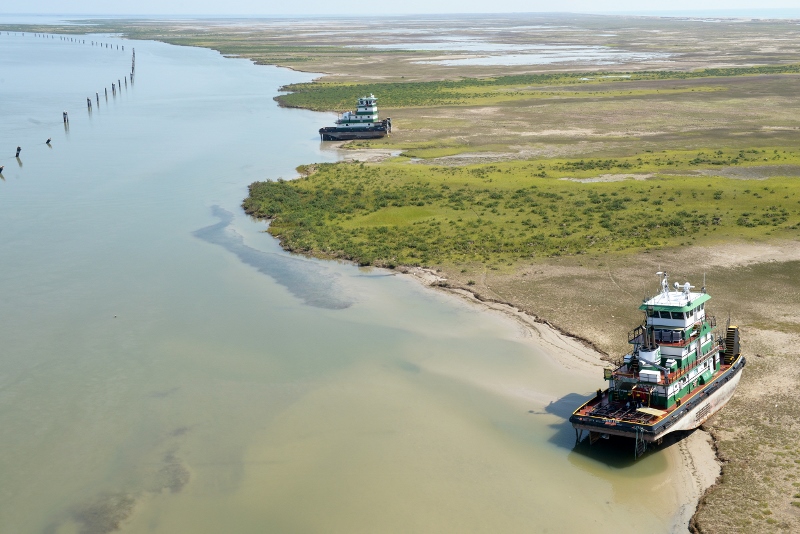The Port of Corpus Christi reopened for limited daylight ship movements, as assessments and aids to navigation repairs continue at Texas ports along the nation’s energy coast stricken by Hurricane Harvey.
The Coast Guard declared the Port of Brownsville open and set conditions for Corpus Christi, including a maximum draft of 43’. Foreign-flag vessels of 100 tons or larger, domestic tank vessels of 10,000 tons or larger, and domestic non-tank vessels of 1,600 tons or larger are required to make one-way transits only, using at least two pilots for each transit, and move only during daylight hours.
Fishing and passenger vessels are still excluded from a security zone in the port without prior permission from the Coast Guard captain of the port. While some channels have been surveyed and aids to navigation reset and repaired, Coast Guard officials cautioned there are still potential hazards with shoaling and debris.

The grounded drillship Paragon DPDS1 was moved enough to one side to allow passage to Corpus Christi. Coast Guard photo/PO2 Cory Mendenhall
But the channel at Port Aransas was cleared enough for traffic to pass the grounded 449'x105'x26' drillship Paragon DPDS1, one casualty as Hurricane Harvey came ashore Aug. 25-26. Salvage preparations continue for the drillship, and three towboats and barges that were part of a Higman Marine Services Inc. fleeting operation that came apart in the storm.
The towboat Belle Chasse sank, and the towboats Sabine Pass and Sandy Point left grounded with the empty barges swept eastward over marshes by the hurricane surge. All 11 crewmembers on the boats were rescued Saturday in a fast-moving Coast Guard helicopter operation by crews of Air Station Corpus Christi, who also picked up the four crew from the sunken 105'x34', 4,400-hp tugboat Signet Enterprise.
Offshore, the federal Bureau of Safety and Environmental Enforcement reported 94 production platforms remained evacuated, down from 102 earlier in the week, as operators boarded as assess their installations. Shut-in production was estimated to be 13.49% of Gulf oil and 17.64% of natural gas.
Overflights by BSEE personnel evaluated platforms and watched for any sign of pollution, but as of Thursday there had been no damage reports, the bureau said.
The reopening of the Port of Corpus Christi was anxiously awaited as a spur to economic recovery. At full operation the port is the fourth busiest in the nation by volume, moving an average $100 million a day in cargo, according to port officials.

Coast Guard aircrews conducted flyovers to assess the ports of Houston, Texas City, Freeport and Galveston, Aug. 31, 2017. Coast Guard photo/PO1Patrick Kelley
Farther up the coast, the Port of Galveston was opened to vessels of less than 33’ draft during daylight hours. At the Port of Houston, the Barbours Cut and Bayport terminals resumed operations Friday morning as ships were cleared for transit.
The Galveston reopening allowed cruise ships to return, six days after the storm forced all to divert. Three Carnival ships, the Carnival Breeze, Carnival Valor, and Carnival Freedom, came back about half full, having diverted earlier to discharge passengers at New Orleans. Royal Caribbean's Liberty of the Seas likewise dropped some passengers at Miami before returning to Galveston Friday.
“It’s a bittersweet feeling for the passengers,” Malcolm Burn, cruise director of the Carnival Freedom, told a Coast Guard public affairs team that covered the return. “They are excited to be back, but are also uncertain of what they are going to see when they get home.”
As on-the-ground damage assessments went on, views of Harvey’s larger effects on the national economy were just starting to form. White House officials estimated 100,000 homes may be damaged by flooding, and the toll appeared well on its way to exceed the damages from hurricanes Katrina in 2005 and Sandy in 2012.
"This is the costliest and worst natural disaster in American history," declared Joel N. Myers, the founder and president of the commercial forecasting service AccuWeather, State College, Pa. Myers said “the total losses from this storm would reach $190 billion or one percent of the nation's gross domestic product, countering the expected growth in the economy for the rest of this year."




